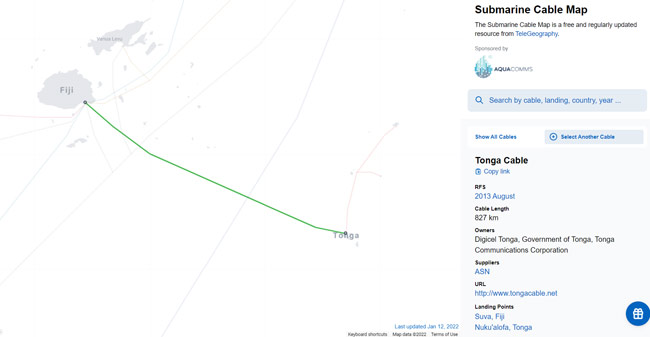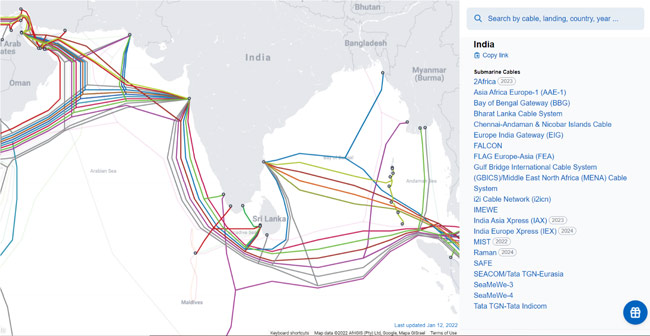Tonga Calamity: Impact of Natural Disasters on Submarine Cables
Tonga, an archipelago situated along the series of fault lines called the ‘Ring of Fire’ in the Pacific region, is quite prone to earthquakes and volcanic activities. On 15 January 2022, the Hunga Tonga–Hunga Ha’apai volcano, which is 65 kms north of Tonga, erupted underwater and led to a cascading tsunami that hit the main island, affecting around 1,00,000 people. Waves up to 4 feet, ash, and clouds of sulfur dioxide engulfed the region.1 The intensity of the shock waves and tsunami was so high that they were felt and detected not only in the Pacific but also in the Mediterranean, Caribbean and Atlantic regions. Scientists have confirmed that a wave like this affecting the entire globe was last observed 20 years ago.2
This virulent volcanic eruption and one of its offset processes (tsunami, water currents, or underwater landslide) snapped the only 827-km-long optical fibre cable that connects Tonga with the rest of the world. This shut down Tonga’s telecommunication with slight clarity on the extent of damage in Tonga.3 Although some of the internal communication and power have been restored, the cable can’t be repaired for at least two weeks due to more anticipated eruptions. New Zealand and Australia sent surveillance flights to assess the destruction and are also assisting Tonga with satellite calls.
The cable seems to have been damaged about 37 km and 47 km away from Nuku’alofa, Tonga’s capital, after which it went into ‘single-end feed’, indicating that power was coming only from Fiji’s side. As shown in Map 1, Tonga is connected to the rest of the world through a US$ 32 million, 3,500 m deep fibre-optic cable that comes through Fiji and is part of 19 submarine cables that spread across the Southern Pacific region. This cable was laid in 2013 through a joint project by World Bank and Asian Development Bank.4 This is not the first time the Tongan cable has broken. A similar mishap happened in 2019 and it took around two weeks to repair the cable again. However, the solution is not simply to add another submarine cable as the position of Tonga is such that the laying of the second cable will also have to be on the same side.5 The Tongan misfortune has cast light on the impact of natural disasters on the global communication systems, especially in the tiny and distant islands. How fragile is the submarine cable system that is responsible for 97 per cent of overseas communication?6 How vulnerable to damage are India’s undersea cables to natural disasters? Is the intensity of such disasters and the possible damage to the global telecommunication system quantifiable? What are the alternatives to submarine cables? The threat to such critical global infrastructure needs a thorough examination.
Submarine Cables: Significance and Challenges
Submarine cables or underwater sea cables are optical fibre cables that are laid on the seabed using ships and connect landing ports. In these fibre-optic cables, data transmission happens through light waves being fired at rapid rates using a thick glass fibre between multiple transmitters, repeaters and receivers. The submarine cables have been in use for 150 years (although the transmission technologies have changed). The first commercial cable was laid in 1850 between England and France by the English Channel Submarine Telegraph Company followed by the laying of the first trans-Pacific cable in 1902 between mainland United States and Hawaii.7 Currently, there are around 436 submarine cables across the globe crisscrossing around 1.3 million km.8 The financial transactions amount to around US$ 10 trillion daily through these networks of cables.9 These cables are owned by consortium telecoms firms that manufacture, deploy and maintain submarine cables and can be state-owned, private or with joint rights. Major tech companies like Amazon, Google, Meta (previously Facebook) and Microsoft are active parties in these consortiums due to their reliance on the Internet and cloud computing. In terms of international laws protecting submarine cables, the existing UN Convention on the Law of the Sea has been neglected and needs sustained international cooperation. An absence of a robust evaluation mechanism of the threats to the submarine cables has put the critical global infrastructure at significant risk.10
The major risks to undersea submarines are natural disasters and man-made activities that can be accidental or intentional. On an average, there are 100 cable faults every year and most accidents happen due to natural disasters, fish trawlers and ship anchors rather than terrorist attacks. There have been at least two instances of terrorist attacks on submarine cables: (1) in 2008, when terrorists cut off three undersea cables causing massive internet outage in Egypt; and (2) attack on Philippines cables in 2010.11 Instances of aquatic life damaging these cables are also quite rare and natural causes for such faults only account for 10 per cent of the total cases.12 Unintentional human mistakes due to ships and fishing vessels’ anchors cause two-thirds of all cable mishaps.13 The International Cable Protection Committee has issued guidelines and a manual to mitigate these human errors. Although these cables are of utmost significance for a major chunk of communication and connectivity, the positioning of these networks is highly unstable. The cables are laid at the shortest distance to save costs and are placed on routes that facilitate mobility, i.e., the “choke points” and narrow passages, for example, the Sundra Strait, Hawaiian Islands, Guam and the Suez Canal. Not only are these locations more prone to man-made accidents, but they are also active volcano zones that lead to earthquakes, underwater landslides and tsunamis causing damage to the undersea cables.14 Some instances of submarine cables fault due to natural disasters are: (1) 2006 earthquake in Taiwan, Hong Kong, China and Southeast Asia; (2) 2011 earthquake and tsunami in Japan; (3) 2015 typhoon in Mariana Island;15 and (4) 2022 volcano eruption and tsunami in Tonga.
Impact on India
As shown in Map 2, India is connected to many submarine cables compared to Tonga’s one cable. The cables are clustered and connected to landing stations. India has five landing stations located at Mumbai, Cochin, Trivandrum, Tuticorin and Chennai, which provide connectivity to the entire nation. Further, Mumbai is connected to eleven cables, making it the busiest station, followed by Chennai with seven cables, Cochin with two, and Trivandrum and Tuticorin with one each.16 Hence, a situation like Tonga is very unlikely to happen to India unless we witness an extinction-level catastrophe, although, in 2008, due to an undersea cable fault along the coast of Alexandria, parts of Egypt, Pakistan, Kuwait and India were left dark for some time.17 Nonetheless, India should have submarine cables protection and alternatives protocol and mechanism in place, especially since Pakistan in its National Security Policy 2022–26 has already emphasised the importance of undersea cables by asserting that:
“The Indian Ocean is fast becoming a space for contestation. The self-professed role of any one country as a so-called net-security provider in the wider Indian Ocean would affect the region’s security and economic interests negatively. Multi-directional challenges in the maritime domain include cyber intrusion and surveillance of our sea lines of communication along the Indian Ocean, among others.”18
Conclusion
Whilst submarine cables are vulnerable to natural disasters, replacing this critical global infrastructure with other alternatives isn’t prudent. Supplementing undersea cables with other systems like Satellite Communication and Underwater Wireless Communication (UWC) is the key to mitigating submarine cable-related losses. UWC that employ 5G wireless networking technique to support radio frequency, acoustic and optical signal carrier will play a significant role in ‘observation of marine life, water pollution, oil and gas rig exploration, surveillance of natural disasters, naval tactical operations for coastal securities and to observe the changes in the underwater environment’ with the proliferation of the Internet of Underwater Things (IoUT).19 Similarly, satellite communication is great for distant locations and data distribution frequency, however, both of these methods are insufficient to accommodate our communication needs. Optical fibre cables transmit a lot of data at a lower price and with high reliability due to their higher bandwidth capacity. Additionally, these cables have great potential of acting as a network of sensors worldwide to detect and monitor earthquakes and tsunamis.20 Innovative approaches can be utilised to repair undersea cables instead of using ships that delay the process. Using Autonomous Underwater Vehicles is a faster, cheaper and safer way to fix the cables. In other words, submarine cables are indispensable.
Views expressed are of the author and do not necessarily reflect the views of the MP-IDSA or of the Government of India.
- 1. “Tonga Volcano Eruption: Satellite Images Show the Extent of Damage”, The Indian Express, 18 January 2022.
- 2. Henry Fountain, “Here’s What Scientists Know about the Tonga Volcano Eruption”, The New York Times, 19 January 2022.
- 3. Dale Dominey-Howes, “When the Lines Go Down: What Tonga Disaster Reveals about Global Telecom”, The Conversation, 17 January 2022.
- 4. Ben Doherty and Tess McClure, “Tonga Could be Cut Off for Weeks amid Efforts to Repair Undersea Communications Cable”, The Guardian, 18 January 2022.
- 5. Tahlea Aualiitia and Edwina Seselja, “Tonga Could be Cut Off from the Outside World for More Than Two Weeks, After Volcano Damages Undersea Cables”, ABC News, 18 January 2022.
- 6. “Submarine Cables”, The National Bureau of Asian Research.
- 7. Dan Swinhoe, “What is a Submarine Cable? Subsea Fibre Explained”, Data Centre Dynamics, 26 August 2022.
- 8. “Submarine Cable Frequently Asked Questions”, TeleGeography.
- 9. No. 6.
- 10. Ibid.
- 11. Alexandra Chang, “Why Undersea Cables are More Vulnerable Than You Think”, Wired, 4 February 2022.
- 12. No. 7.
- 13. No. 8.
- 14. Dale Dominey-Howes, No. 3.
- 15. No. 6.
- 16. Monit Khanna, “A Giant Web of Submarine Cables Connects India to the Internet and World”, Indiatimes.com, 3 April 2021.
- 17. Alexandra Chang, No. 11.
- 18. “National Security Policy of Pakistan 2022-2026”, National Security Division 2022, p. 25, 14 January 2022.
- 19. Mohammad Furqan Ali et al., “Recent Advances and Future Directions on Underwater Wireless Communications”, Archives of Computational Methods in Engineering, Vol. 27, pp. 1379–1412, November 2020.
- 20. Zhongwen Zhan et al., “Optical Polarization–based Seismic and Water Wave Sensing on Transoceanic Cables”, Science, Vol. 371, No. 6532, 31 August 2019.










